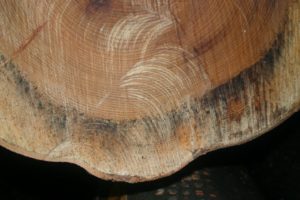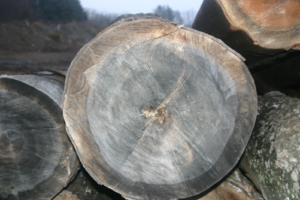By Alex Anderson, forest products specialist, Rhinelander
The devastation left behind in forested areas after a severe weather event can seem overwhelming. In order to further understanding of how storm-damaged forest and woodlot salvage harvests differ from traditional timber sales, we have compiled information that will, hopefully, help landowners affected by the recent rash of severe weather events in Wisconsin deal with their damaged woodlands more confidently.
Wood Degradation
Many of the downed trees from July’s severe weather are red pines (Pinus resinosa). Pines, particularly white pine (Pinus strobus) and red pine in the Lake States region, are susceptible to staining when they are harvested or killed during a weather event but are not processed quickly enough. The discoloration is a result of microscopic fungi that manifest as a pale, blueish stain in the wood often called “blue-stain” or “sap-stain.” Though there is a small, decorative market for blue-stained pine—sometimes referred to as “denim pine”—it is generally undesirable. Hardwood species are also susceptible to blue stain fungi. End coating logs with a wax barrier may reduce the risk of staining and end checking.


These logs show blue staining.
Another common issue that degrades logs in Wisconsin is the discoloration of “white” woods, such as red and sugar maple, following extended periods of log storage prior to milling. This discoloration is commonly seen as a host of color variations within the wood after sawing and drying. By harvesting in the winter months, this discoloration can be largely avoided; however, trees that are damaged or lost during a severe weather event in the summer months are at risk of developing this discoloration. This issue, since it affects hardwoods typically utilized in aesthetic applications, downgrades the lumber and, therefore, lessens its market value.
Finally, there are forest health concerns, such as a beetle infestation, that can occur when large numbers of trees are destroyed in a weather event. Pine stands, in particular, are known to play host to vast quantities of beetles that can, eventually, infest nearby, previously healthy stands. Once a tree dies, whether it has been snapped off along its bole or been pulled out by the roots, it is best to salvage the timber out of that tree before degrade occurs. While there is some degradation that is inevitable in a severe wind event—such as cracking, which renders some logs unusable to sawmills—much of the timber is still salvageable if it can be harvested in a timely manner.
Merchantability
When a timber sale is established, trees are harvested to achieve forest management objectives. Trees are selected to improve stand diversity, wildlife habitat, and aesthetics, and may be harvested when they have reached their peak economic value; however, when a wind event occurs, damage is often unpredictable. There are technical challenges and safety concerns after a windstorm—spring poles and other stressed wood, along with slower production due to the number of downed trees laying in various directions on the forest floor, make for slow progress. Furthermore, a number of trees killed or injured during the storm are considered pre-merchantable. This term means, simply, that a tree is too small to be utilized profitably. These trees, which normally remain standing during a commercial harvest so they can continue to grow, are nearly impossible to find markets for.
A certain percentage affected, however, is large enough to be considered merchantable. In general, most logs with a top diameter of at least 4 inches have the potential to be commercially utilized. Pulpwood, which is the primary raw material for pulp mills throughout the state, is generally small-diameter or of quality making it unusable at sawmills. Both softwoods and hardwoods can be utilized as pulpwood, but their utilization depends on the specifications of the pulp mill purchasing the logs. Next in size are bolts, which generally range from about 8” to 12” in diameter and are most often used for pallet stock. Finally, larger logs and high-quality logs are generally considered saw logs. Saw logs are utilized for appearance grade lumber—which is turned into furniture, millwork, flooring, etc. In addition, saw logs are milled into dimensional lumber and industrial products such as timber mats and railroad ties.
Markets
Landowners are best served by consulting with a forester to determine what is best for their property. Foresters are generally able to help landowners navigate the potential confusion of a salvage harvest by managing the technical aspects of setting up a timber sale. Foresters partner with loggers who understand which markets are available for the different products harvested from a sale, so they can ensure that the product is utilized to its highest value.
Currently, there are limited markets for forest biomass across Wisconsin, which means residues from brush, tree tops, branches and any mixture containing those elements, will be difficult to utilize profitably. Furthermore, given soft market conditions statewide, pulpwood and certain saw log species such as red oak (Quercus rubra), red pine and white pine may also be difficult to market. If markets don’t exist for a product or a certain size class of tree, this timber may go unutilized; however, local uses, such as firewood, posts or mulch, are options for unmarketable timber. However, it is important to avoid transporting firewood and other materials to prevent the movement of invasive pests. To view a map of primary wood-using facilities in Wisconsin, visit the DNR’s mill-mapping tool.
Though not all solutions for landowners with damaged woodlands are ideal, Wisconsin is fortunate to have vibrant forestry, logging and forest products communities. Without them, severe weather events, such as the ones that caused widespread damage across Wisconsin, would leave many more landowners without timely and effective solutions. If you need a salvage harvest and would like to work with a forester in your area, visit the forestry assistance locator.
While this article strives to give a basic overview of how storm damage can affect forest products, here are some additional articles on these topics:
- Utilizing Storm-Damaged Timber – NC State Extension
- Timber Salvage – MSU Extension
- Storm Damage to Forests – Wisconsin DNR
- Marketing Dead Timber – USDA Forest Service
